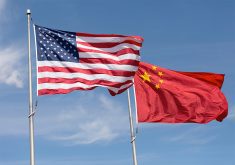The Canadian agriculture industry is bracing for impact as Trump’s 25 per cent tariffs are set to become reality on Tuesday.
U.S. President Donald Trump on Saturday signed an order to place 25 per cent tariffs on Canadian and Mexican imports and 10 per cent on goods from China.
Energy products from Canada will have only a 10 per cent duty, but Mexican energy imports will be charged the full 25 per cent, the officials told reporters.
Trump has declared the national emergency under the International Emergency Economic Powers Act to back the tariffs, which allows sweeping powers to address crises.
Read Also

Larkin to step down as Grain Growers of Canada Executive Director
Kyle Larkin will step down as executive director of Grain Growers of Canada (GGC) at the end of December.
The White House officials said there would be no exclusions from the tariffs. Moreover, in the case of Canada specifically, they said the “de minimis” U.S. tariff exemption for small shipments under $800 would be canceled.
Trump originally said he would sign an executive order imposing the tariffs on his first day in office, linking the move to border issues and demanding Canada and Mexico clamp down on the flow of illegal drugs and migrants to the U.S. The order was then pushed back to Feb. 1.
Bracing for impact
A 25 per cent tariff is expected to have serious consequences for Canadian-grown agricultural commodities like grain, pork and beef.
Manitoba alone sends about three million piglets each year to producers in Iowa, Minnesota, South Dakota and Nebraska, where feed corn can be sourced more cheaply, according to the Canadian Pork Council and Manitoba Pork Council.
Midwestern farmers then raise and fatten the animals before sending them to slaughter. Pork flows to buyers in the U.S. and Canada after processing.
Manitoba piglet producers have been having uncomfortable conversations with U.S. buyers about who picks up the tariff bill.
“These pigs can’t stop flowing,” Manitoba Pork Council Chair Rick Prejet told Reuters this week, adding that there are not enough Canadian farms to fatten piglets to slaughter weight.
Prejet said American farmers need Canadian piglets because there are not enough born in the U.S. That means the piglet trade will likely continue in the short term even if tariffs are imposed.
“There will have to be a negotiation between buyer and seller,” said Prejet.
In an interview late last year, Manitoba Pork Council general manager Cam Dahl said Trump’s statements are the latest manifestation of a gradual non-partisan slide into U.S. protectionism.
“For example, we have a country of origin labelling that’s come back and is going to discriminate against Canadian live cattle and live hogs. We have things like individual state initiatives on animal welfare like Proposition 12 in California,” he said.
The original country of origin labelling rule, rolled back in 2015, was mandatory, while the new U.S. version is characterized as voluntary, although Canadian producers say that distinction will make little practical difference.
Proposition 12 sets out animal treatment standards for products sold in California. Critics are worried about the impact of state-specific rules on the harmonized value chain.
Dahl noted the sheer number of animals sent from Manitoba to the U.S. every year.
“On an annual basis, the pork industry contributes about $2.3 billion to Manitoba’s GDP. We employ about 22,000 people, and when you take away the largest market that those 22,000 people are working to fill, of course it would have a big, big impact in Manitoba,” said Dahl.
“And that’s not just for hog producers. That’s across the entire province.”
On the beef side, the Canadian beef industry expects $2 billion in live cattle exports and at least $4 billion in beef exports to the U.S. over 2024, said Laycraft. Canada is also a large import market for U.S. beef and cattle, he noted. Around $500 million in live cattle and about $1.5 billion in beef imports from the U.S. will come into Canada this year.
Canada Agriculture and Agri-Food Minister Lawrence MacAulay has expressed confidence in Canada’s ability to navigate the trade landscape under the new U.S. administration.
Canada’s minister of agriculture maintains that the cross-border trade relationship can weather the tariff storm.
“We’ve dealt with the Trump government previously and we’ll do it again,” Lawrence MacAulay told reporters Nov. 26. “We will deal with each issue as they come forward.”
MacAulay said Prime Minister Justin Trudeau spoke with Trump shortly after the new tariff comments were made. The ag minister also pointed to a re-established cabinet committee on Canada-U.S. relations, which he said will focus on such issues.
Laycraft, likewise, believed there was a reasonable chance the highly integrated nature of U.S.-Canada trade would drive support for maintaining the status quo on both sides of the border.
“I think when people look at the benefits on the total increase in trade and being able to have these solid trade agreements with your most trusted trading partners, there’s a lot more pros than cons in any review or renegotiation moving forward,” he said.
The CCA and stakeholders planned to analyze different scenarios and outcomes and share that information with producers.
“In situations like this, the best you can do is try and give people the best possible information to make decisions moving forward,” Laycraft said
Potash mining company BHP suggested that diversification will be its answer to the U.S. tariffs.
“We have a strategy to be geographically diversified with our sales, so we will not just sell to the U.S. We will sell all over the globe,” said Karina Gistelinck, asset president of potash for BHP in Saskatchewan, late last year.
“Obviously, the U.S. is a big end-user consumer for potash, and we will take that into account.”
Gistelinck added that “tariffs come and go” and the Australian-owned BHP prioritizes resilience to tariffs and other price changes.
Dahl said he hoped the tariff threat will drive better recognition of the U.S.-Canada ag trade relationship among stakeholders like the federal government.
“Our provincial government is very engaged,” he said. “We need to have that on the federal side of agriculture and food, as well as the other provinces, to really reach out and have these conversations with individual states as well as with representatives and senators and the new administration coming in.”
—With files from Karen Briere, Janelle Rudolph, Geralyn Wichers and Reuters
















